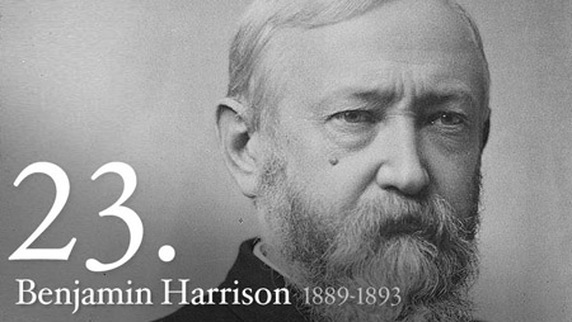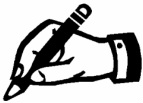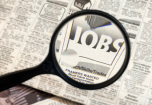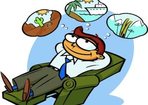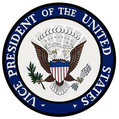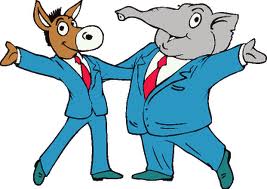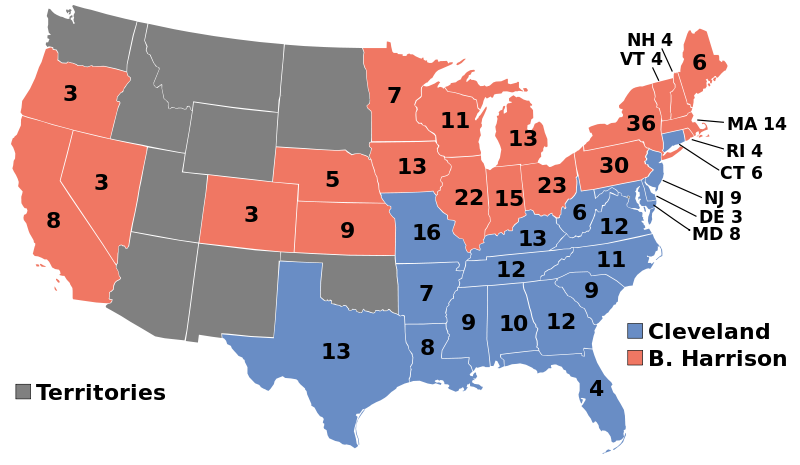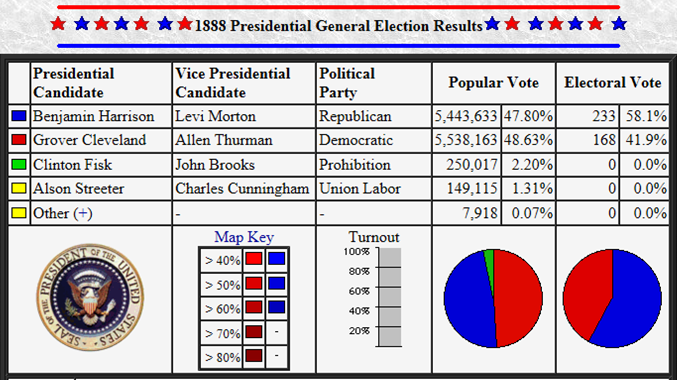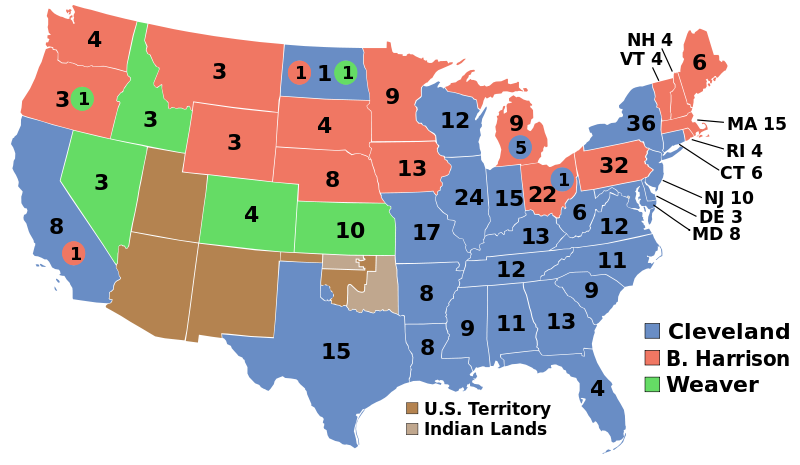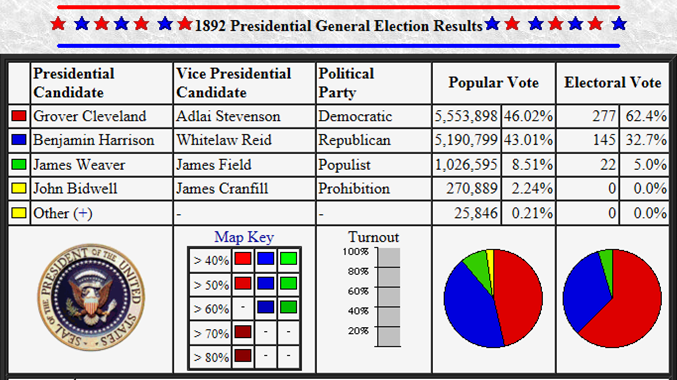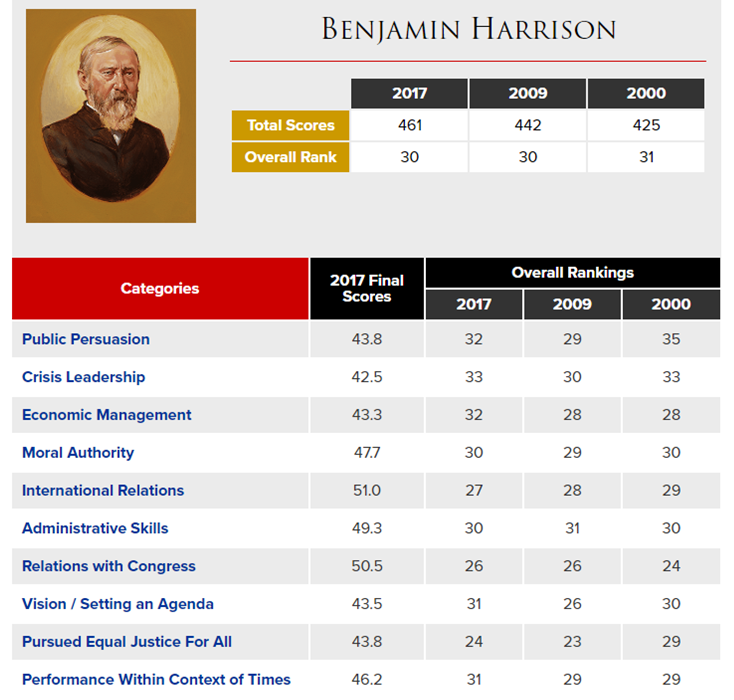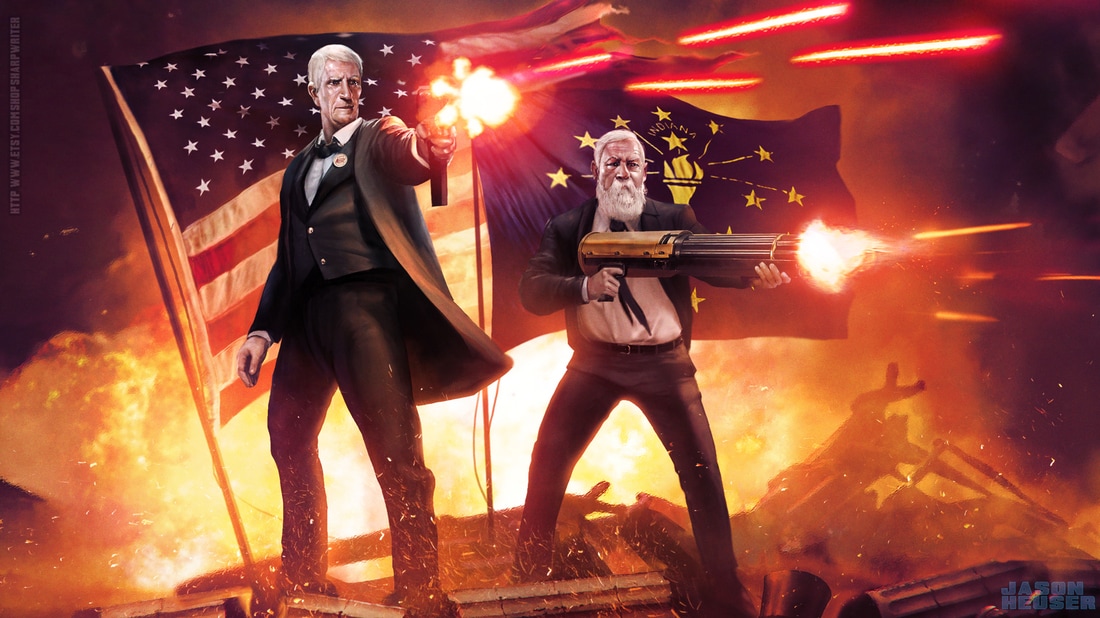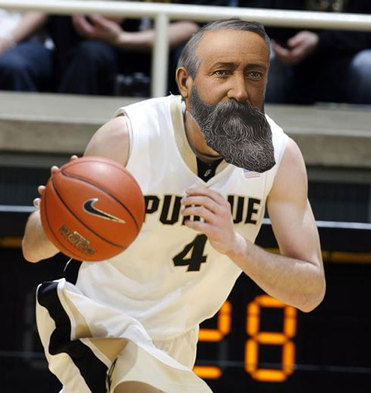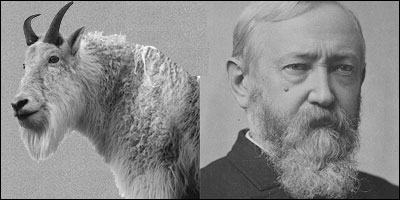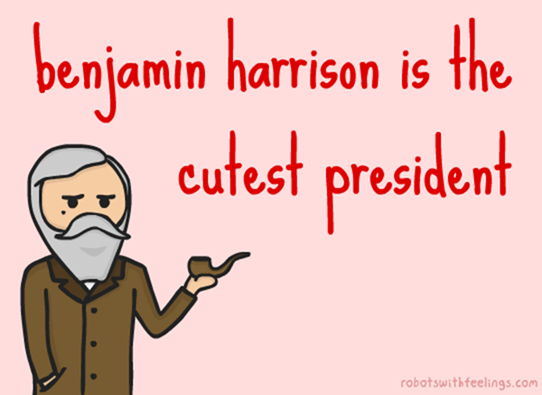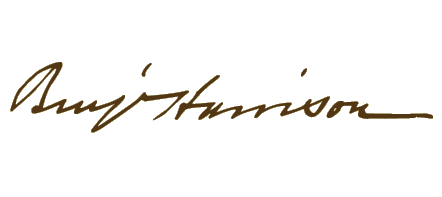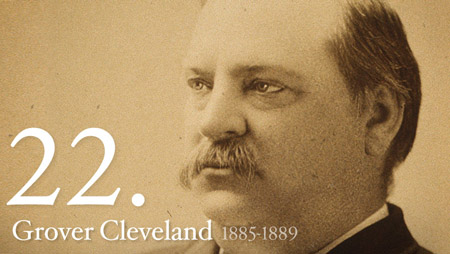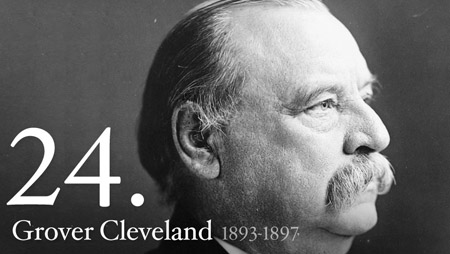Scramblin' thru... the U.S. Presidents
"The White House Iceberg"
"Kid Gloves"
"Little Ben"
"The Front Porch Campaigner"
Personal Information
|
Level: College
(Miami University of Ohio) |
Married: Twice
(Caroline, 1853 & Mary, 1896) |
Biological Kids: 3
(2 kids with Caroline & 1 kid with Mary) |
Presidential Information
Election Information
Election of 1888
Election of 1892
A Presidential Life in Review
|
Benjamin Harrison followed the distinguished example of his grandfather
William Henry Harrison all the way to the White House, beating incumbent Grover
Cleveland in the Election of 1888. As the 23rd U.S. President from 1889 to
1893, Harrison is best remembered as being the guy who served between
Cleveland's two non-consecutive terms. While his support for protective tariffs
led to rising prices for consumers and paved the way for America's future
economic woes, his bold pursuit of foreign policy goals (including
his proposal to annex Hawaii) displayed his vision of
the nation's role in world affairs. In 1890, Harrison signed into law the
Sherman Antitrust Act, the first piece of legislation designed to prohibit
trusts and monopolies. In 1892, he lost his bid for re-election
to the same man he had beaten four years earlier. Harrison remained active in
public life as a lawyer and public speaker until his death in 1901. Source: The
History Channel
|
Historical Rankings
Click here to learn more about the C-SPAN Survey
Benjamin Harrison Fun Facts
Harrison was a grandson of President William Henry Harrison and the great-grandson of Benjamin Harrison V, a Virginia governor and signer of the Declaration of Independence. Harrison was seven when his grandfather was elected President, but he did not attend the inauguration.
Harrison was the last Civil War General to serve as U.S. President. In August 1862, Harrison joined the Union Army at Louisville, Kentucky, soon rising to the rank of colonel in the 70th Indiana Infantry. For much of its first two years, the 70th Indiana performed reconnaissance duty and guarded railroads in Kentucky and Tennessee. In 1864, Harrison and his regiment joined William T. Sherman's Atlanta Campaign and moved to the front lines. On January 2, 1864, Harrison was promoted to command the 1st Brigade of the 1st Division of the XX Corps. He commanded the brigade at the Battles of Resaca, Cassville, New Hope Church, Lost Mountain, Kennesaw Mountain, Marietta, Peachtree Creek, and Atlanta. When Sherman's main force began its March to the Sea, Harrison's brigade was transferred to fight in the Battle of Nashville. On March 22, 1865, Harrison earned his final promotion: the rank of Brigadier General. He was honorably discharged on June 8, 1865.
Harrison was the second of 13 children in his family.
Harrison was so afraid of electric lights that he had his staff turn the switches on and off for both him and his wife.
Harrison was the second President whose wife died while he was in office. Caroline died from tuberculosis in 1892. (John Tyler was the first to lose his wife, Letitia, while President. Woodrow Wilson became the third President to lose his wife, Ellen, while in office.) Harrison's daughter took over the official responsibilities of the First Lady for the remainder of his term, the last time a non-spouse served as U.S. First Lady.
Harrison signed the Sherman Antitrust Act of 1890 into law. This was designed to help prevent the formation of monopolies and, if formed, help break them up. However, as it was funded and administered, the legislation had no teeth until President Theodore Roosevelt gave it his full attention.
Harrison was known by some as the "White House Iceberg" or the "Human Iceberg" because he was often very formal and stiff when dealing with people.
An excellent speaker, Harrison once made 140 completely different speeches in 30 days.
When Harrison moved into the White House, it was so run down and dilapidated that plans were drawn up to build a new mansion elsewhere in Washington, D.C.
For the Election of 1888, Harrison ran a "Front Porch Campaign". Staying at home in Indianapolis, he would speak to any groups that wanted to show up and talk to him. (Not exactly an aggressive campaign.) His opponent was the incumbent President Grover Cleveland. Cleveland won the Popular Vote by 90,596 votes (48.6% to 47.8%), but Harrison won the Electoral Vote 233-168. As such, Harrison became President. (Of course, during a rematch four years later, Cleveland won the Election of 1892 by taking the Electoral Vote 277-145 and the Popular Vote by 380,810 votes.)
There have been a total of five U.S. Presidents elected without winning the Popular Vote: John Quincy Adams (1824), Rutherford Hayes (1876), Benjamin Harrison (1888), George W. Bush (2000), and Donald Trump (2016).
On November 2, 1889, Harrison signed the proclamations admitting North and South Dakota to the Union. Due to a rivalry which existed between the two states, Harrison ordered the papers to be shuffled and for the names to be hidden from him while signing so there would be no argument over which he signed first. We don't actually know which one was signed first because it was never recorded. However, since North Dakota is before South Dakota alphabetically, its proclamation was printed first in the Statutes At Large, making North Dakota the 39th state.
Harrison's last daughter, Elizabeth, whom he had with his second wife, Mary, was younger than his four grandchildren.
Harrison was the last President to sport a full beard... until President Benjamin J. Hartnell.
Following his marriage, Harrison moved to Indianapolis to begin practicing law. One of his first jobs there was as a "crier" for the Federal Courthouse. This meant he was responsible for walking the streets of Indianapolis and announcing decisions passed by the judges. He eventually opened his own law firm and also served as a public attorney and law reporter for the Indiana Supreme Court.
Harrison was the first U.S. President to have his voice recorded. The audio recording is a 36-second clip of Harrison reading from one of his speeches.
In 1896, Harrison got married for the second time to a woman who was not only 25 years younger than him... but who was actually his own niece by marriage. His new wife, Mary, was the daughter of his deceased wife's sister, meaning she was not a blood relation to Harrison, but was a first cousin to Harrison's children. His children refused to attend the wedding, and the union caused an estrangement between Harrison and his daughter. They never spoke again.

